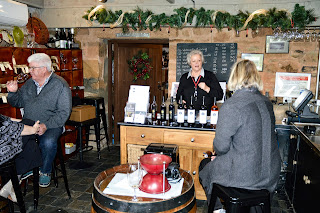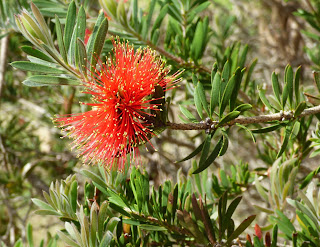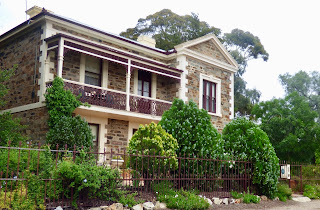He he - I couldn't resist that title.
The Clare Valley is surrounded by gentle hills and is home to an enormous number of top quality wineries. Some are nestled snuggly on the valley floor surrounded by gum trees ...
...while others boast expansive views from hilltop sites.
Time for some tastings. We plotted a route to take in a number of wineries. The scenery was peaceful and relaxing - rolling hills studded with acres of bright green vines with a background of softer hills in the distance; narrow winding roads bordered by tall gum trees; welcoming winery signs with enticing names such as Good Catholic Girl, Sussex Squire Wines, Sevenhill Cellars, Mad Bastard Wines ...
Here I am at Crabtree Watervale Winery, a small boutique winery that had the most delicious riesling. Because of virus restrictions we all had to sit apart from others, but that was fine with us. And when I spied some cointreau orange marmalade on the shelf, I just had to have it. We were off to a good start.
After tastings and purchases at Tim Adams and O'Leary Walker, we headed off for lunch at Paulett Wines and their restaurant recommended by the people at the Information Centre. It was certainly delicious and boasted bush tucker foods from their own native garden. Here is my crumbed lamb with muntries (a native berry that exploded in the mouth when crunched on, giving me a crisp juicy taste rather like an apple) and celeriac with a caramel coating. Not cheap, but I have to say it all went very well with a sparkling white.
We could hardly move afterwards as we are not used to huge midday meals so it was back to our accommodation and feet up. After a few hours rest and recuperation, we were ready for some exercise.
We decided to visit Neagles Rock Lookout. I always head to the information board located at the beginning of walks to get an idea of what I am going to see and why it is important. Well..... the information on this sign seemed to be taken from a scientific journal with no thought to who would be reading it, that is, ordinary folks like us. I did learn that it is the most 'signifiant structural discontinuity in the Clare Valley' (but not what 'structural discontinuity' means), but I was lost with the next statement that 'often the silicified zones are extensively brecciated and may be recemented with more silica than iron oxides'. So we set off knowing we were going to see something that was geologically important. It was a gentle uphill walk.
The rocky summit itself was much smaller than I had envisaged but it gave us a good view over the Skillogalee valley.
Steve clambered over the outcrop to get better shots, while I reclined as a lady should.


That night we enjoyed a wonderful Indian meal. Tomorrow .... more wine tasting, exploring and eating!
An inviting open gate.
Artichokes and vines.
Everywhere, the vines were looking very healthy and we were told that harvesting would take place in January. These young grapes would be well and truly ready by then.
I loved the courtyards set up for tastings. This is at Shut The Gate Winery, looking cool and inviting.
On our last morning before leaving, we set off for a walk along the Riesling Trail just opposite our accommodation. The entire trail runs 33 kilometres from Auburn to Clare, following a disused railway line.
It was peaceful, quiet and cooly invigorating in the early morning. We took our time to savour the surroundings, imagining the train puffing along the very straight route in its heyday. My eye caught a vibrant bottlebrush on the side of the trail.
As we walked, a number of cyclists whizzed by enjoying the freedom to ride without fear of traffic.
It was time to go, but not before Steve got in one last shot.
Driving homewards, but not time to call it a day yet, we called in at the pub in the little settlement of Sevenhills in search of an intriguing wine. We had been told about it at the Indian restaurant we had been to the night before. Jim Barry (of Jim Barry Wines) had visited the Greek island of Santorini in 2006, where he came upon a wine called Assyrtiko which he thought tasted rather similar to Clare Valley rieslings, but was somehow different. He began importing cuttings. Then in 2012 the first of the vines were planted. The Indian restaurant was selling bottles for $50 but we believed we might get it cheaper at the Sevenhills pub. In we went. The lovely young bartender lady there said she thought they had it and we had better go down into cellar to check. Off we went and entered the most gorgeous cellar filled with bottles. We hunted in every refrigerator shelf and on racks to no avail. Perhaps it's upstairs she says. A little disappointed we climbed back to the bar area where she began her search again. Suddenly a shriek and a smile and a 'Here it is'. So we bought it (yes, it was much cheaper!) and headed the car home.Here's part of our haul. I say 'part' because Steve also bought a box of a dozen rieslings that were selling as an excess run and had to be sold; we had tasted the wine and thought it was delicious. I think we're set now for the next few weeks!!!!!!




















































